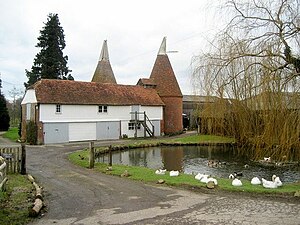
An oast, oast house (or oasthouse) or hop kiln is a building designed for kilning (drying) hops as part of the brewing process. Oast houses can be found in most hop-growing (and former hop-growing) areas, and are often good examples of agricultural vernacular architecture. Many redundant oast houses have been converted into houses. The names "oast" and "oast house" are used interchangeably in Kent and Sussex, but in Surrey, Hampshire, Herefordshire and Worcestershire they are called "hop kilns"[citation needed].
An oast house consists of a rectangular one- or two-storey building (the "stowage") and one or more kilns in which the hops were spread out to be dried by hot air rising from a wood or charcoal fire below. The drying floors were thin and perforated to permit the heat to pass through and escape through a cowl in the roof which turned with the wind. The freshly picked hops from the fields were raked in to dry and then raked out to cool before being bagged up and sent to the brewery. The Kentish dialect word kell was sometimes used for kilns ("The oast has three kells") and sometimes to mean the oast itself ("Take this lunchbox to your father, he's working in the kell"). The word oast itself also means "kiln".[1]
The earliest surviving oast house is at Golford, Cranbrook near Tunbridge Wells. It dates from some time in the 17th century and closely mirrors the first documentary evidence on oasts soon after the introduction of hops into England in the mid-16th century. Early oast houses were simply adapted barns, but by the 18th century the distinctive tall buildings with conical roofs had been developed to increase the draught. At first, these were square, but around 1800 roundel kilns were developed in the belief that they were more efficient. Square kilns remained more popular in Herefordshire and Worcestershire and came back into fashion in the southeast in the later 19th century. In the 1930s, the cowls were replaced by louvred openings as electric fans and diesel oil ovens were employed.
Nowadays hops are dried industrially and the many oast houses on farms have now been converted into dwellings. One of the best-preserved oast house complexes is at the Hop Farm Country Park at Beltring.